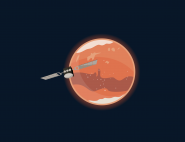Observations of the south seasonal cap of Mars during recession in 2004-2006 by the OMEGA visible/near-infrared imaging spectrometer on board Mars Express
Langevin Y., Bibring J.-P., Montmessin F., Forget F., Vincendon M., Doute S., Poulet F., Gondet B.
Journal of Geophysical Research E: Planets
Summary: The OMEGA visible/near-infrared imaging spectrometer on board Mars Express has observed the southern seasonal cap in late 2004 and 2005 and then in the summer of 2006. These observations extended from the period of maximum extension, close to the southern winter solstice, to the end of the recession at Ls. 325°. The spectral range and spectral resolution of OMEGA make it possible to monitor the extent and effective grain size of CO2 ice and H2O ice on the ground, the level of contamination of CO2 ice and H2O ice by dust, and the column density of µm-sized ice grains in the atmosphere. The CO2 seasonal cap is very clean and clear in early southern winter. Contamination by H2O ice spreads eastward from the Hellas basin until the southern spring equinox. During southern spring and summer, there is a very complex evolution in terms of effective grain size of CO2 ice and contamination by dust or H2O ice. H2O ice does not play a significant role close to the southern summer solstice. Contamination of CO2 ice by H2O ice is only observed close to the end of the recession, as well as the few H2O ice patches already reported by Bibring et al. (2004a). These observations have been compared to the results of a general circulation model, with good qualitative agreement on the distribution of H2O ice on the surface and in the atmosphere. Resolving the remaining discrepancies will improve our understanding of the water cycle on Mars. © 2007 by the American Geophysical Union.


